Homeowner Associations (HOAs) were established to protect property values by controlling the appearance of homes and the landscape of front yards and common areas. The Community Associations Institute estimates that over sixty million people now live in neighborhoods governed by HOAs. By regulating types of plants and amount of turf, HOA boards are responsible for the environmental health and function of large areas of green space and they exert significant influence on aesthetic preferences and cultural landscape norms for neighborhoods. In some cases aesthetics are emphasized over environmental health in landscape regulations. Although the principles of Florida-Friendly Landscaping™ (FFL) emphasize environmental health of the landscape, with careful design a Florida-friendly landscape can also be visually appealing and "fit" with the desired neighborhood landscape look.
Many homeowners are beginning to rethink their landscapes for several reasons, including mandated water and fertilizer restrictions, the increasing costs of high-maintenance landscapes, and a growing concern for environmental impact, particularly to our water bodies. Landscape improvements include reducing the amount of turf in front and back yards, replacing high-water-demand plants with drought tolerant plants, creating bird and butterfly gardens, and adding edibles to their landscape. However, HOA regulations can make it difficult to implement some changes by mandating types of plants, percentages of turf and plant material, location of plant materials, and restricting specialty gardens to back yards. More environmentally sound landscapes are possible with careful planning and design and by using an educated and knowledgeable approach to working with the HOA board to gain approval for a new landscape. Below are several strategies for working within HOA regulations to gain approval for a Florida-Friendly landscape:
Strategy 1: Become Familiar with Florida-Friendly Landscapes
Learn about the nine principles of Florida-Friendly landscapes. The first principle, right plant-right place, emphasizes the selection and layout of plant material based on the site conditions such as sun and shade and on soil moisture. Principle #5 encourages selecting plants for wildlife, and Principle #9 encourages the use of a low-maintenance landscape buffer along water bodies. Although the other principles emphasize maintenance, they also influence design by encouraging the selection of long-lived, hardy, low-water-use plants that are pest tolerant. (See EDIS publication https://edis.ifas.ufl.edu/ep079, Florida Yards and Neighborhoods Handbook 2009.) It is also important to learn about other landscape features and hardscape structures that can be used in a FFL yard. (See EDIS publication https://edis.ifas.ufl.edu/ep424, Landscape Elements for a Florida-Friendly Yard.) Understanding the principles and incorporating landscape features suggested below can create a Florida-Friendly landscape and still meet the landscape requirements of most HOAs.
Locate plants in traditional foundation plant beds—Locate plants in typical plant beds that are found in most traditional yards—usually around the foundation of the house and separate small beds in the turf (usually around trees). The primary difference is an increase in the size of the beds: make them as large as possible while still maintaining the required percentage of turf (Figure 1).
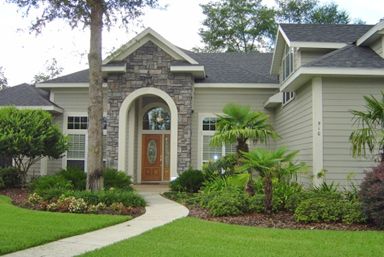
Credit: Florida- Friendly Landscaping™ Program
Mulch in plant beds—Use mulch in plant beds to maintain soil moisture and suppress weeds. Mulch can also serve as a ground cover in shady areas where plants will not grow and in sitting areas or other activity areas. Fresh mulch (top dressed frequently) will make plant beds look neat and the plants look healthier (Figure 2).
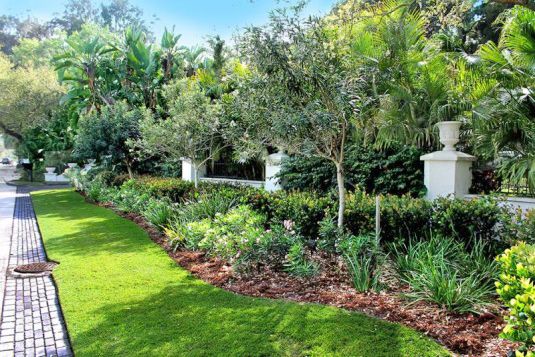
Credit: Florida- Friendly Landscaping™ Program
Use turf strips along sidewalks or curbs in front yards—Studies have shown that maintaining a mowed strip of turf between the sidewalk (or curb) and foundation plants in the front of the yard will make the turf area appear larger and the entire yard will be perceived as neater and better maintained (Figure 3).
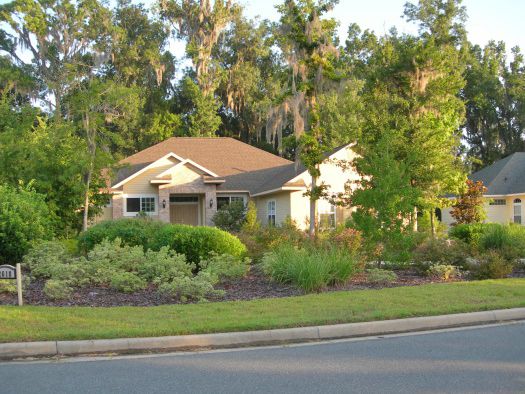
Credit: Gail Hansen
Use trees for shade, energy efficiency, and color—Plant as many trees as the regulations allow. The trees will help shade the house and air conditioner units to reduce cooling costs in summer. Trees also provide variety in the landscape by varying the height, form, and texture of plant material. Flowering trees are also a good way to create color in the garden and reduce the use of annuals, which typically are high maintenance, high water use, and short-lived (Figure 4).
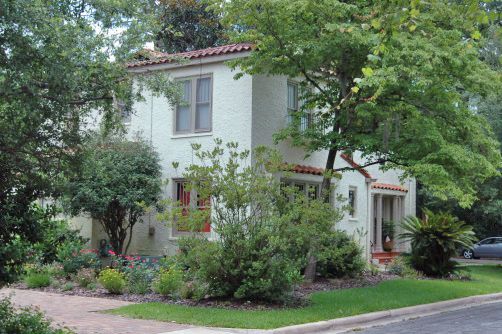
Credit: Erin Alverez
Use a variety of plant material for biodiversity—A variety of plant material will encourage pollinators and other valuable and pretty wildlife. Another benefit of having diversity in plant materials is a more interesting landscape, with different textures, colors, and forms. Although variety is important for biodiversity a more cohesive look can be achieved by grouping similar plants and repeating the groups throughout the garden (Figure 5).
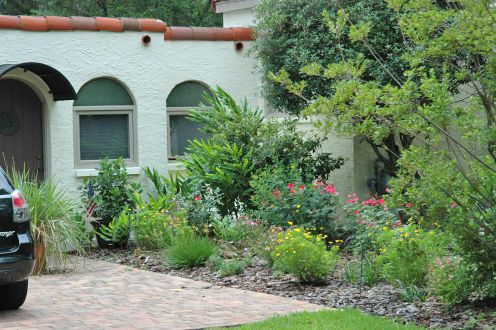
Credit: Erin Alverez
Install an irrigation system: in-ground or above ground micro-irrigation)—In-ground systems are recommended for turf and above-ground for plant beds. (See EDIS publication https://edis.ifas.ufl.edu/ae436, Summary of IFAS Turf and Landscape Irrigation Recommendations.) Irrigation will be needed to establish a new landscape and should be turned off in the plant beds once plants are established. The system can also be used during extreme dry periods. Use the latest technology, such as soil moisture sensors and rain sensors, to optimize the system. Cisterns and rain barrels could also be used, but most HOA regulations will require them to be placed in the backyard or side yard and hidden by a fence (Figure 6).

Credit: Center for Landscape Conservation and Ecology
Include a low-maintenance zone along a water edge—Many homes in newer housing communities are located around stormwater ponds and small lakes. Often the pond shoreline is a common area that is maintained by the community association and the homeowner has little responsibility for maintenance. However, homeowners can protect water quality by following UF/IFAS recommendations for turf fertilization. If the homeowner is responsible for maintenance to the water's edge, it is important to establish a 10-foot-wide low-maintenance buffer that will absorb stormwater runoff (Figure 7). Research the types of plants that will do well on the water edge and in the water. (See EDIS publication https://edis.ifas.ufl.edu/ep476, Florida-Friendly Plants for Stormwater Pond Shorelines.)
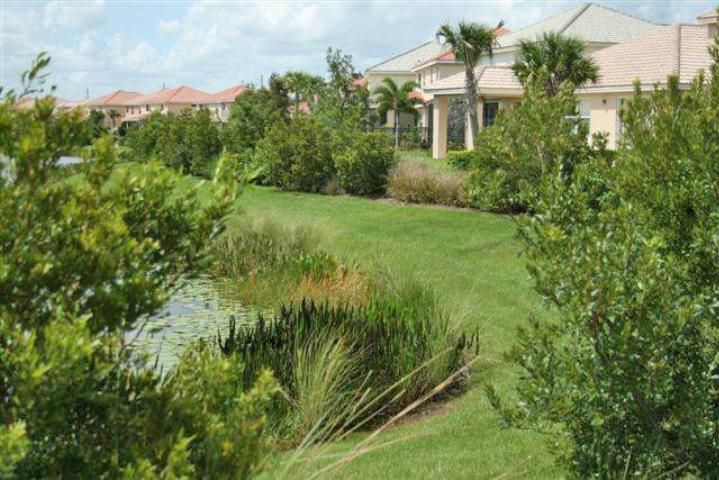
Credit: Florida-Friendly Landscaping™ Program
Design for maintenance—Consider maintenance by selecting the right plants for the site conditions. Reduce turf to reduce mowing time and use mulch to keep weeds down. Plants that require little trimming to maintain a nice shape and size will minimize maintenance (Figure 8). Keep the plant palette simple—use enough plants for biodiversity and interest but not so many as to make maintenance complicated with many different maintenance needs throughout the year. (See EDIS publication https://edis.ifas.ufl.edu/ep442, Twenty-Two Ideas for a Low-Care, Low-Cost Landscape.)
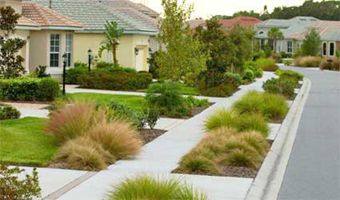
Credit: Florida-Friendly Landscaping™ Program
Strategy 2: Understand the Florida-Friendly State Law
A new Florida law, effective July 1, 2009, gives homeowners greater rights to implement Florida-friendly landscaping on their properties and requires water management districts to work with local governments and organizations to promote these practices. Section 373.185 Florida Statutes, "Florida-friendly landscaping ordinances," defines Florida-friendly landscaping as "quality landscapes that conserve water, protect the environment, are adaptable to local conditions, and are drought tolerant." Paragraph (3) (a) of the law states, "The Legislature finds that the use of Florida-friendly landscaping and other water use and pollution prevention measures to conserve or protect the state's water resources serves a compelling public interest and that the participation of homeowners' associations and local governments is essential to state's efforts in water conservation and water quality protection and restoration." Paragraph (3) (b) states, in part, "A deed or covenant may not prohibit or be enforced so as to prohibit any property owner from implementing Florida-friendly landscaping on his or her land." And paragraph (3)(c) states, "A local government ordinance may not prohibit or be or be enforced so as to prohibit any property owner from implementing Florida friendly landscaping on his or her land."
(See EDIS publication https://edis.ifas.ufl.edu/ep440, Questions and Answers: 2009 Florida-Friendly Landscaping Legislation.)
Strategy 3: Become Familiar with Your HOA Landscaping Rules and Regulations
When purchasing a home in a deed-restricted community you agree to abide by the covenants when you purchase the home. If you did not read the fine print at the time of purchase, now is the time to retrieve the covenant document and review the information. Below are suggestions for specific information to note, including the approval process for new and retrofit landscapes. It is also helpful to talk to neighbors who have worked with the board members about their experience.
Review your association approval process—Check the homeowner association covenants and become familiar with the landscaping requirements and the approval process. Understanding the process and how the board will make decisions will help you develop your request. It is also helpful to know if there is a special landscaping committee and what role they play in the approval process. Members of a landscape committee may be available to answer questions and guide the process.
Meet your HOA board members—Learn about the responsibilities of the board members. Will they have final say in the design or will a special landscape review board or committee have the final say? Can the board make recommendations for changes or will they simply approve or deny the entire plan? Are the board members familiar with Florida-friendly landscape principles and do they support the principles?
Check plant lists and regulations—Review the recommended or required plant lists. Are the plants designated as Florida-friendly? If the codes do not include a plant list is there a recommendation for using the Florida-Friendly Landscaping™ Guide to Plant Selection & Landscape Design to select plants? If there are no recommended or required plants, contact your local extension office or go to the Florida-Friendly Landscaping™ program website and begin to gather information about plants. A very helpful tool is the Florida-Friendly Plant Guide Mobile Web Application which can be downloaded at https://ffl.ifas.ufl.edu/plants.
Check turf requirements—Make sure you understand how the calculations for turf requirements work in your yard. For example, if the turf requirement is written as a percentage of area, such as 50 percent of the front yard, you must know the area (square feet) of your front yard to figure out how much of your yard will require turf. If turf is required in side swales/easements you will need to check your property boundary survey for the dimensions of the easement to calculate the turf required.
Note restricted elements—Review all the restricted elements, particularly for the front yard. If there are elements that you would like to use, such as stones, benches, or sculptures, read the fine print to understand the limitations. Inquire about the restrictions if the regulations are not clear; small things can derail your entire plan, especially if the restriction, such as the use of stones or ornaments, or the height of benches or sculptures, is noted in the covenants. Board members often focus on these measurable restrictions.
Read your association newsletter—The newsletter will often have articles and information about topics that concern the upkeep and appearance of the community, which typically includes landscaping. Recommendations for selecting plant materials and landscape contractors are often included and any local, county, or state ordinances that apply are often noted. Some newsletters will feature yards that are considered particularly appealing, and this will give you some indication of the preferences of the board members.
Review your property boundary survey—Become familiar with all the easements, including utility and drainage; all the setbacks and build-to lines, including building and structure limits; and all the special limitations such as buffer zones, lake/wetland jurisdiction lines, and protected areas (Figure 9). All of these areas are typically called out in the landscape covenants for special treatment.
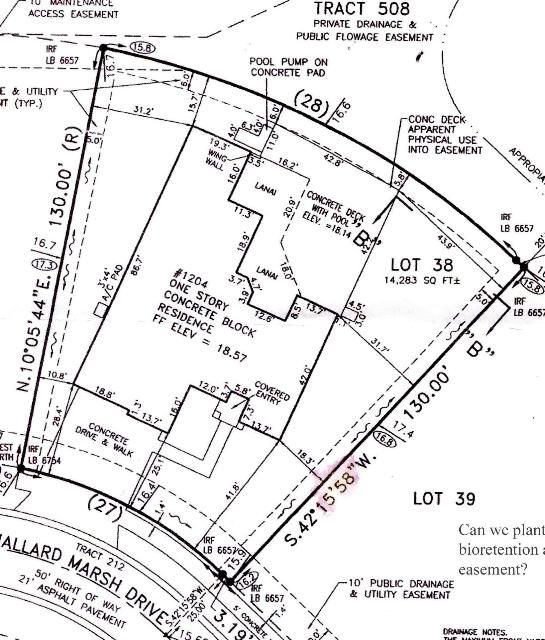
Credit: Gail Hansen
Talk to neighbors—Neighbors who have been through the approval process for a Florida-Friendly landscape can provide advice based on their experience. If possible, speak with neighbors who have been approved and those who may have been denied to identify what they did differently.
Strategy 4: Observe Landscapes in Your Community
Take note of other yards in the community for clues to acceptable landscapes. You will begin to notice the repeated use of certain plants and a general configuration of the plant beds. A new landscape that closely resembles existing yards is most likely to be approved, as a high priority for board members is to maintain a cohesive look in the community.
Study the style of the yards in your neighborhood—Use the typical style as a guide for your new design. You can make your yard unique without deviating too much from the norm. For example, do not create an entire yard of stones when the rest of the neighborhood is turf and plant material (Figure 10). The style is the overall look of the yard, but it includes the amount of turf versus the amount of plant material and the type of plants such as trees, shrubs, and groundcover.

Credit: Florida-Friendly Landscaping™ Program
Note the arrangement and layout of plants—Most Florida home landscapes are very traditional in form, including foundation shrubs that circle the house and turf to the sidewalk or street. The simplest way to create a Florida-friendly landscape and comply with the HOA landscape requirements is to make the plant beds larger and reduce the turf areas while maintaining the same layout (Figure 11). Enlarging plant beds will require additional plants in the beds, which creates an opportunity to include a greater variety of plants.
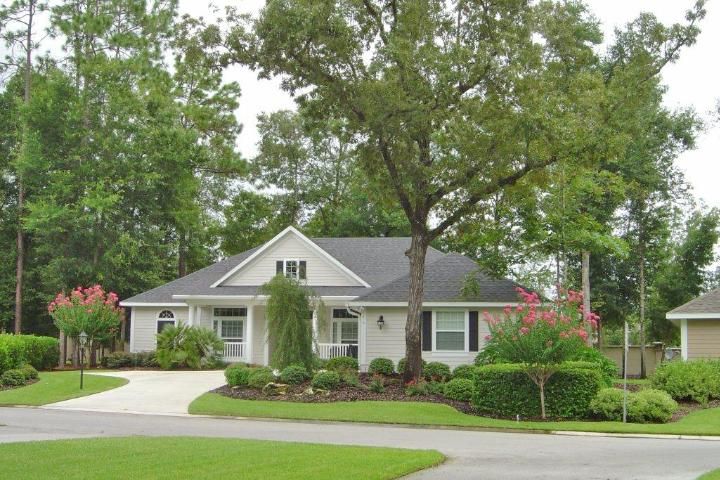
Credit: Florida-Friendly Landscaping™ Program
Note plant choices—Note plants, including trees, that appear to grow well in the neighborhood. Ask neighbors about plants in their yards, including questions about maintenance and growth habits. Some yards that look beautiful are high maintenance and have high time requirements. Match your plant selection to your time and skill level (or the standard maintenance activities of your contractor) for landscape maintenance activities. Make a list of the plants you like and take photos.
Note use of turf in the yards—The location of turf is important. Some communities require a continuous strip of turf that connects the yards for a mowing strip from yard to yard. Look at homes with the least amount of turf (assuming they meet the minimum requirement) to picture the amount of turf you will need for your yard. Most yards will have more than the minimum requirement, so the typical may not give you a good feel for how little turf you can use. Most communities will specify the type of turf, but if you have a choice make note of the type of turf that grows well in the area.
Strategy 5: Study Photos of Florida-Friendly Yards from Other Communities
Look for photo examples of Florida-Friendly yards from other communities on the FFL web site or the web page of your local Extension office. Your local office will often have photos of good examples that will convey a variety of looks that are Florida-Friendly. The most noticeable difference is usually less turf and more plants.
Collect photos of FFL yards you like—Study the photos and think about the "fit" with your neighborhood: does the yard in the photo look like it would blend with your neighbors' yards? If you hire a landscape designer, the photo will give them an idea of the look you want and it can also serve as a guide if you chose to do it yourself (Figure 12).
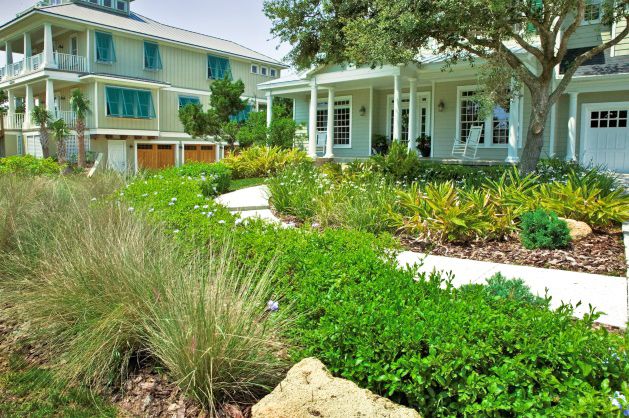
Credit: Florida-Friendly Landscaping™ Program
Include photos in your application to the board—Find photo examples of yards from the same region (north, central, or south Florida) so the plant material in the photo is similar. The photos can be included in your application to convey to the board the look you intend for your new landscape. They are most helpful if they show plant material that will grow in your area (Figure 13).
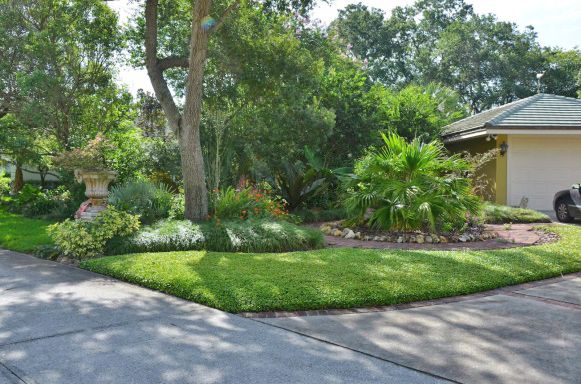
Credit: Florida-Friendly Landscaping™ Program
Strategy 6: Do an Inventory and Analysis of Your Yard
Your application most likely will require a landscape plan showing what and where you intend to plant. Typically the board will require only a simple plan, but even simple plans need thoughtful decisions on plant choice and location. To do this you will need to inventory (record) the existing conditions in your yard and analyze (decide) how this will affect your plant choices.
Record site conditions in your yard—Note sun and shade areas to determine the types of plants that will grow in the yard and the amount of plants needed for each area (Figure 14). See EDIS publication https://edis.ifas.ufl.edu/ep426, Landscape Design: Analyzing Site Conditions, for more information on site inventory and analysis.

Credit: Gail Hansen
Gather soil samples—Take soil samples in several locations in the yard where new plant material is proposed. A soil analysis at your local Extension office will give you the information to make appropriate plant selections. (See EDIS publication https://edis.ifas.ufl.edu/ss494, Soil Sampling and Testing for the Home Landscape or Vegetable Garden.)
Analyze the site conditions—An analysis of the site will help you determine potential problems on the site and possibilities for new design. Constraints typically include drainage problems, underground utility restrictions, and setback and easement restrictions. Opportunities for new design often include larger plant beds, space for more trees, and possibilities for new hardscape such as pathways.
Strategy 7: Create a List of Florida-Friendly Plants
One important aspect of a Florida-Friendly yard is the type of plant material. The Florida-Friendly Landscaping™ program has developed a list of plants that meet certain environmentally friendly criteria such as low water use, hardy and long-lived, appropriate for cold-hardiness, relatively pest free, wildlife friendly, and availability at local nurseries. Many FFL plants are native to Florida, but that is not a requirement, as many horticulture plants also meet the criteria. The key is to locate the right plant in the right place for its growing requirements.
Compile a list of FFL plants—Use the Florida-Friendly Landscaping™ Guide to Plant Selection and Landscape Design or the FFL Plant Guide Mobile Web Application. Make a list of plants that you would like to use that will grow in your USDA hardiness zone. Florida zones range from Zone 8 (north Florida) to Zone 11(south Florida).
Compare your FFL list with your list of plants that grow well in your neighborhood—If plants grow well in your area and are low water and low maintenance, they are considered to be Florida-Friendly even if they are not in the plant selection guide. Selecting plants in the plant guide may increase the chances of having the proposed landscape approved by the board members.
Check your list against the recommended plant list from the HOA—If your HOA has a recommended (or required) plant list, it is important to make sure most of your plant choices are on the list. Most HOA plant lists are developed with the help of landscape designers or in consultation with landscape contractors and will include plants that do well in the area. Your plan is more likely to be approved if it includes many of the recommended plants.
Research turf for your area—If your landscape covenants allow different types of turf check the UF/IFAS recommendations for your area. Base your selection on conditions in your yard and the growing requirements for the turf. If you have dense shade you may have to ask the board to consider an alternate ground cover. (See EDIS publication https://edis.ifas.ufl.edu/entity/topic/book_florida_lawn_handbook_3rd_ed Florida Lawn Handbook.)
Strategy 8: Use Hardscape or Groundcover in Your Yard
Some homeowners would like to reduce the turf in their yard to decrease maintenance time and irrigation costs. There are several options to replace turf that are typically accepted under most covenants as long as you retain the minimum required amount of turf. A variety of surface treatments can also add interest to the landscape.
Think about ways to incorporate other materials—Landscapes can include rocks, gravel, garden walls, decorative fences, mulch, garden structures (arbors, trellises), and furniture (Figure 15). However, these elements must be integrated into a good design—a front yard that is only rocks is not a good design and likely will not be approved. Check to make sure the covenants will allow structures and/or furniture and if there are size restrictions.
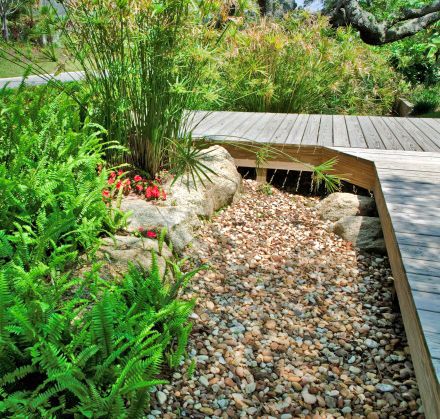
Credit: Florida-Friendly Landscaping™ Program
Incorporate pathways—Use pathways to spatially organize plant beds and turf areas in the landscape. Substituting mulch or gravel pathways for turf areas also reduces the amount of irrigation water needed. Pathways can create a wide edge around plant beds which will make the plant material look neater and well organized. They also make it easier to access the plants for maintenance (Figure 16). Use porous materials such as pavers on a sand base to promote drainage. (See EDIS publication https://edis.ifas.ufl.edu/ep408, Sustainable Landscape Construction: Aggregates and Precast Pavers and Blocks).
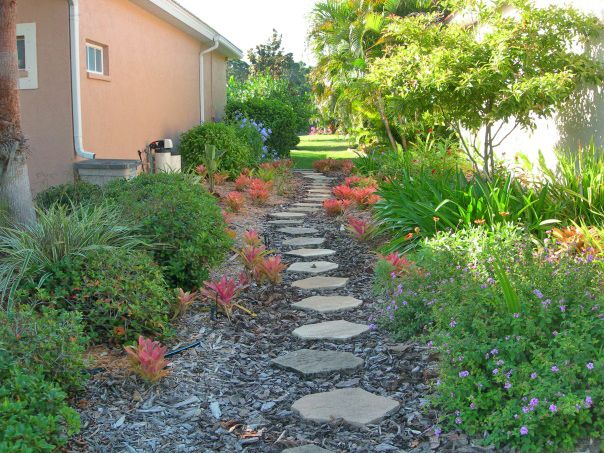
Credit: Gail Hansen
Design hardscape areas first—Wide front walkways or a large back patio that fits with the style of the house can reduce the amount of turf and still provide functional surfaces for outdoor activities (Figure 17). Using pervious pavers and having the hardscape professionally designed and installed often will add value to the property.
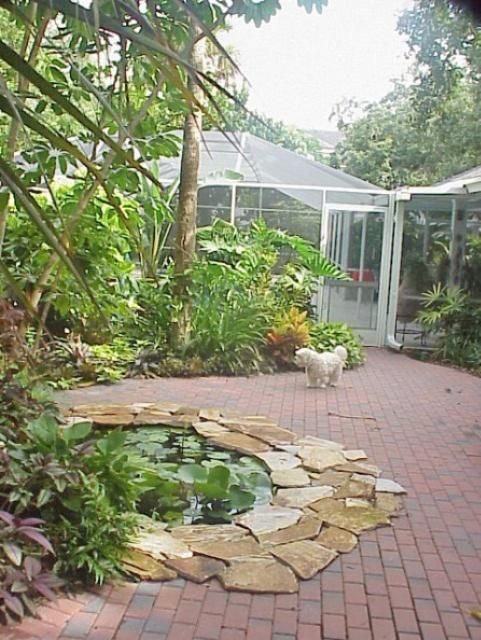
Credit: Florida-Friendly Landscaping™ Program
Strategy 9: Develop a Landscape Plan
Although a simple landscape plan can be a DIY project, a signed and sealed professional plan will offer assurances to the board that the plan is well designed. Most landscape design professionals are familiar with FFL principles and plants and many have experience designing environmentally friendly landscapes. If the approval process allows representation, some designers will present the plan to the board members.
Draw a master plan (or hire a professional)—A plan on paper shows the location and type of all the plants (Figure 18). Be sure to include the names of the plants and the quantity of each. Give spatial details—for example, indicate on the plan how much (in square feet) of the new landscape is turf, how much is plant bed, and how much is other material such as rocks, mulch, or hardscape. (See EDIS publication https://edis.ifas.ufl.edu/ep427, Landscape Design: Putting your Yard on Paper.)
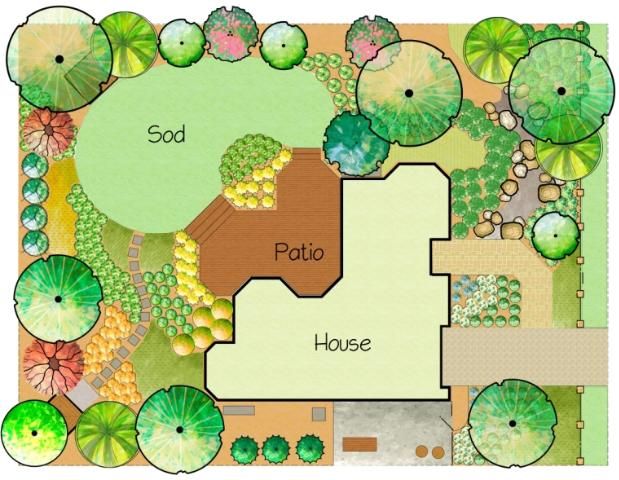
Credit: Gail Hansen
Include photos with the plan—Photos of the plants on the plan will show the visual quality of the plants and help the board members visualize what the finished landscape will look like (Figure 19). Studies have shown that many board members are unsure of what a Florida-Friendly yard looks like and would be more likely to accept a plan that provides visual content such as photos. Photos of individual plants can be found in the Florida-Friendly Landscaping™ Guide to Plant Selection and Landscape Design.
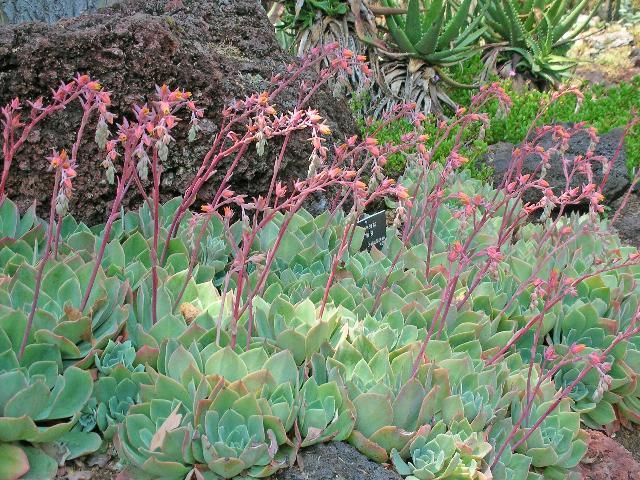
Credit: Center for Landscape Conservation and Ecology
Strategy 10: Include a Description of the Landscape in Your Application
A written description will help explain the look and intent of the new landscape. This is particularly helpful if you are not present during the approval process, and it is good opportunity to show the board members that you have followed the covenant requirements.
Explain neighborhood fit—Describe how your new yard will fit with existing yards in the neighborhood. Include photos of your neighbors' yards on either side to show how your landscape will blend with theirs.
Explain your plant choices—Describe how you are using plant material that already exists in the neighborhood and how any new plant material "fits" the look of the neighborhood. Describe the benefits of using the new plants such as water conservation, butterfly attraction, and low maintenance. It is also helpful to describe special features of the plants, such as seasonal color or unique form.
Summary
Gaining approval of your proposed landscape is more likely if you follow the strategies outlined in this document. The most important concept is assuring the board members that your landscape will not deviate greatly from the neighborhood norm and the aesthetic appeal or "look" of the landscape will be maintained. As the homeowner it is your responsibility to understand and accept the covenants you agreed to when purchasing the property. The key is to use the strategies that work with the covenant restrictions yet allow a more Florida-Friendly landscape.